A Lot More Western Swing
By
Leocthasme
More
It has been some time since my
last article on the History of Western Swing, the first article appeared in
October 2000 followed by two more in subsequent issues of Pencilstubs.
Click on the URLs below if you want to refer to them.
http://www.pencilstubs.com/magazine/MagPage.asp?NID=319
http://www.pencilstubs.com/magazine/MagPage.asp?NID=824
http://www.pencilstubs.com/magazine/MagPage.asp?NID=1004
Since the last article appeared,
I have had many letters, e-mails, and comments about the articles and have been
asked to continue with more information on this genre by those who wrote to me,
e-mailed me, and sent first hand information and family pictures of the stars
from their personal collections.
Beside Bob Wills, and Hank
Thompson to whom I have given much space in the previous articles, many others
of note had much to do with Bob Wills’ Western Dance Music, as he termed it,
and Western Swing as it was named by Spade Cooley, who called himself ‘The
King of Western Swing’.. Cooley coined
the term 'Western Swing'. Before
that, the music had been called everything from 'Hillbilly', a definite
misnomer, to 'Texas Swing', which is much more correct.
"Spade", given the nickname
from his poker playing habits, had everything going for him. He owned a 20 acre
'ranch' on Ventura Boulevard in Los Angeles, a 15 million dollar fortune in
1961, America's largest Swing band, the longest running Television show, and he
was probably the most popular entertainer west of the Mississippi River.
In 1961, it all ended for
"Spade" when he forced his young daughter, Melody, to watch as he
murdered his second wife (Ella Mae Evans) because he thought she was having an
affair with cowboy film star Roy Rogers. Eight years later, he died of a
coronary while still serving time, after being on release to play for a
Sheriff's benefit concert. More on
Spade Cooley as I give a bit of history of the most popular bands.
During the heyday of Western Swing,
there were thousands of bands playing all over the West. Yet, there were only a
handful of bands, playing Western Swing, predominantly in Oklahoma, Texas, and
California. For most people, the
word 'Swing' evokes memories of the great ‘Big Bands’, so named because of
their size and sound that played all over America from the late 1920s on through
the 1950s. However, to many hometown Americans, there was still another 'Swing',
Western Swing. That was played in
the roadhouses, county fairs and dancehalls of small towns throughout the Lower
Great Plains.
The music was strictly for dancing, and
included mostly the simpler one and two step dances with quite a few foxtrots
along with both "cowboy" and "Mexican" waltzes. Vocals were
handled by a group of the sidemen, but most often, it was the leader's job. In
fact, the popularity of the Leader/Singer usually determined the band's success.
These local bands could play the same music that the big bands played, but
because of the smaller instrumentation, and "local style", the
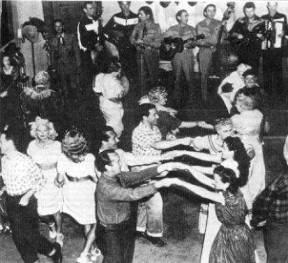 music had a different
"feel", it wasn't a Big Band sound, it was much more ensemble playing,
often with a guitar, or a violin predominating. The folks who came to the
roadhouses were of course, all the 'locals', everyone knew everyone else, and
their ages ran from the young folks to the old-timers, friends and neighbors,
husbands and wives, all could spend some time together listening, drinking, and
dancing the weekend nights away. Here
is a picture of a typical dance hall of the 30’s. music had a different
"feel", it wasn't a Big Band sound, it was much more ensemble playing,
often with a guitar, or a violin predominating. The folks who came to the
roadhouses were of course, all the 'locals', everyone knew everyone else, and
their ages ran from the young folks to the old-timers, friends and neighbors,
husbands and wives, all could spend some time together listening, drinking, and
dancing the weekend nights away. Here
is a picture of a typical dance hall of the 30’s.
'String Bands' fathered the music,
which became known as Western Swing. It originated in the Texas and Oklahoma
lower Great Plains area. These
early String Bands often were composed of just a Mandolin, Banjo, a standard
6-string Guitar, and a 4-string "tenor guitar" (a Baritone Ukulele -
popular in the Southwest and in Mexico). Mostly,
the music consisted of just instrumental "breakdowns" because the
vocalists could not be heard clearly above the noise. The local dancehalls
didn’t have, nor could they afford big mikes and speakers.
Folks who were either too poor to afford Dance Hall admissions, or too
far away from one, would hold weekly "house" parties where local bands
performed very much like the "rent" parties of the 'Jazz Age'
generation in Chicago. They would
roll up the rug, throw some cornmeal on the living room floor, and invite every
neighbor they knew, for a weekend-long party. There were no admission charges,
it was simply a form of low cost entertainment and everybody ‘pitched in’
for the refreshments.
The Southwest population consisted of a
good sprinkling of German Irish, English, and many French emigrants.
The music was representative of an area's ethnic and economic background.
At first, the songs and the "Hot Licks" were passed along between just
the local musicians. Even the early
radio and recording industry contributed to the "localization" of the
music. The recording company executives felt that playing records on the air
would hurt their sales. And so,
during radio's, so-called, golden era, much of the music played was by live
bands in the radio studios. Since
the music was heard only by people in the station's listening area, the region's
musical identity was thus codified. Later,
mass marketing of Records and newer radio broadcasting made the music and styles
of all areas available to musicians in all localities.
We can say that continuing from the
early 1920’s on, the music, which probably best reflected the local ethnicity,
slowly began to resemble first "Country" music, and finally mirrored
the music that the Big Bands were playing.
It differed from the Big Bands in that the instrumentation was not the
same, and the style was more ensembles playing for the simpler 1 and 2 step
dances. Following this same pattern, Western Swing would later have elements of
Bop and then Rock and Roll. The Western Swing we know today evolved from this
breaking down, via Records and Radio, of "Regional Area only"
entertainment.
There was a curious series of events
for this new age of Recording. On
the one hand, it broke the racial, religious, and social barriers that had
existed. But, on the other hand,
due to marketing techniques, new "artificial" boundaries were created.
Recording company executives felt that 'markets' existed for
'specialized' music forms, and so, 'Race Records' (for Black listeners),
'Hillbilly' (for the rural listeners), and 'Western Swing' (for the Western
states, Oklahoma, Texas, Louisiana, and California, where most of the former
‘Okies’ moved to), were newly formed market niches. There was a very
unfortunate aspect to all of this. folks who didn't consider themselves to be
Black, or Hillbilly, or Western, tended to avoid buying such ‘labeled’
records. Thus, Western Swing never really caught on in the sophisticated East
Coast markets, but was extremely popular throughout the Southwest and the West
Coast.
Probably the best known of the very
early Western Swing bands were Milton Brown and his Brownies, and Bob Wills and
The Texas Playboys, but there were hundreds more who managed to achieve some
fame, even if in just their own regional area.
In time, many of the 'old timers' died, but Western Swing survived.
Most of Bob Wills' sidemen, such as his guitarists Tiny Moore and Eldon
Shamblin, along with his fiddler Johnny Gimble, continued the Western Swing
tradition. There were such rock-era bands as 'Commander Coty's Lost Planet
Airman'; Alvan Crow's 'Pleasant Valley Boys', and 'Asleep At The Wheel'. In
addition, there was a great deal of "cross-over" performances.
From the Jazz world, Stan Kenton recorded with Tex Ritter, while Charlie
"Yardbird" Parker jammed with Ray Price's 'Cherokee Cowboys'. Jazz
vibrophonist Gary Burton and Bassist Steve Swallow went into RCA's Nashville
recording studios. It worked in reverse too. Such well known Jazzmen as Hank
Garland and drummer Joe Morello had their early training with Paul Howard's
Arkansas Cotton Pickers. Other examples are Vassar Clements who cut two albums
of 'Hillbilly Jazz', and Roy Clark who formed his own big band.
Any listing of ‘Western Swing
Bands’ should include:
The Light Crust Doughboys, 1930
- The Southern Melody Boys
1931 -
Milton Brown and His Brownies, 1932
- The High Flyers, 1937
- The Tune Wranglers, 1935
- Bob Wills and The
Texas Playboys -
Adolph Hofner and His San Antonians, 1946
- Bill Boyd (1910-1977) and
The Cowboy Ramblers - Spade Cooley and His Orchestra
- Tex Williams (1917-1985)
and The Western Caravan -
"Texas" Jim Lewis (1909-1990) and His Lone Star Cowboys
Hank Thompson (1925- ) and His Brazos Valley Boys - Bill Haley
(1925-1981) and His Comets. A brief
history of these bands is included
The music started to metamorphose in the late 1950s. A form of music
arose called Western Bop, and then Rockabilly, which had roots in Western
Swing., then just ‘down to earth’ Honky Tonk, which was a form of Western
Swing played by 3 or 4 piece bands in the big city beer joints, and then new
Aftro-American BeBop rhythms. Neither
BeBop nor Western Bop lasted very long. Less
than half a decade later, BeBop had become discredited as a musical form, and
Western Bop had been replaced by a slightly different music known as Rock and
Roll. You can still hear ‘Honky
Tonk’ in a lot of neighborhood bars on a Friday or Saturday night, played by
local musicians, mimicking the popular recordings, a sort of Western Swing that
most folks can dance to, or listen to and cry in their beer over ‘lost love’
lyrics.
The 1950's were a historical moment. A
gap began to form between the generations. The Rock and Rollers wanted nothing
to do with the musicians that preceded them, a palpable sign of ignorance.. 1951
saw the creation of a group called Bill Haley and The Saddlemen, which later
became Bill Haley and The Comets. Still,
Western Swing's influence was felt in the popular recordings of the day.
In the 1960's, the acoustic folk music
movement and 'Rockabilly' groups such as 'The Stray Cats' kept Western Swing
alive.
In the 1970's, there was still another
resurgence of Western Swing. Austin, Texas became a major music center where the
music of Bob Wills and Milton Brown was continued by men such as Willie Nelson
of Abbott, Texas and Waylon Jennings.
The Austin scene is alive and well.
thanks to the annual 'South by Southwest' music festival. In the late 1980's, the band 'Asleep At The Wheel' became
highly successful due to their ‘Austin City Limits’ TV show, on which the
band played the great Western Swing tunes, often featuring many of the
old-timers of Western Swing.
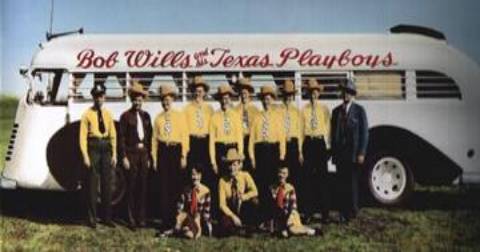 Today, the name 'Western Swing'
still evokes nostalgic images of Cowboys with Fiddles, steel Guitars, and Drums,
touring the countryside in buses and vans. And, even though that era has ended,
the influences of those early musicians can still be heard in today's Country
Music. Today, the name 'Western Swing'
still evokes nostalgic images of Cowboys with Fiddles, steel Guitars, and Drums,
touring the countryside in buses and vans. And, even though that era has ended,
the influences of those early musicians can still be heard in today's Country
Music.
And the Beat Goes On!
Leo C. Helmer
And now, so that you don’t have to go
through the database of Band Names I have picked out the ones that I mentioned
above and here is a bit of history on each one.
You can get all sort of information if you so desire. At this site, http://nfo.net/usa/
The Light Crust Doughboys.
In
hindsight, we can now see how a band with the curious name of 'The Light Crust
Doughboys' came into being. Their
radio sponsor was the Burris Flour Company.
They were the first regional band to appear in a Hollywood film, they had
a future Texas Governor as one of the group, and two of the original members
went on to form famous bands of their own; Bob Wills and Milton Brown.
Hank Thompson, who was with the Doughboys much later, also formed his own
band; one that continued the Western Swing tradition beyond its golden era.
In the late 1920's, ‘Barty’ Brown and his two sons, Milton and
Derwood would often entertain their Fort Worth neighbors. It was Brown's first
band, 'The Aladdin Laddies', that became the "Light Crust Doughboys".
The 'Doughboys', a string band, formed in 1930, first consisted of Bob Wills
(violin); Truett Kimzey (their announcer); Milton Brown (vocals), and Herman
Arnspiger (guitar). The history of
this band is inextricably bound up with the person of W. "Pappy" Lee
O'Daniel (1890-1969). O'Daniel had been elected to the board of directors for
Burris Mills Flour and he conceived the thought of sponsoring the band on a
local radio station as a means of increasing the firm's sales of flour.
O'Daniel’s interest in the group was
life-long. It lasted though the band's early years to his ownership of his own
Flour Company, and on to his becoming Governor of Texas. Texans loved the Doughboys, and this admiration for the band
rubbed off onto "Pappy" O'Daniel.
They saw him as an entrepreneur who really cared for the 'common man'.
O'Daniels later used this admiration to help him win the Texas Governorship. But
the Public's image of O'Daniel as an entrepreneur who could be trusted by the
'common' folk, was quite different from reality. O'Daniel kept the Doughboys
salaries below the poverty line, and was not at all liked by the bandsmen. The
band was 'officially' formed in 1930, and O'Daniel placed them on local station
KFJZ. It is safe to say that Milton Brown's vocalizing made the band an instant
success. So, O'Daniel’s bet that the band's popularity would increase Burris
Flour sales had paid off. He then changed Radio Stations, going from KFJZ to
KTAT, where O'Daniel secured the band's announcer job for himself, dismissing
Truett Kimzey. Except for Brown's singing, no member of the band was permitted
to speak 'on air', just O'Daniel. Milton
Brown, the band's talented singer, contributed greatly to the band's early
success. He even brought in his (underage) younger brother Derwood as an unpaid
guitarist. In 1932, he asked Pappy O'Daniel for a raise, or failing that to pay
Derwood a salary. O'Daniels refused forcing Brown to resign. Milton and Derwood
left the "Doughboys"; formed another band, and returned to KFJZ, where
they became a powerful competitor to the Doughboys.
O'Daniel brought in Tommy Duncan as Brown's replacement singer. The
band's style now changed drastically. Bob Wills started doing some comedic
routines in between band numbers. He was a real crowd pleaser and a rivalry
(decades long) between him and O'Daniel ensued (eventually landing them both in
court). Duncan's singing (similar in style to Jimmy Rodgers, "The Blue
Yodeler", was also very well received by the public. Eventually, Wills, and
much later, Hank Thompson also left and formed their own bands. The orchestras
of Milton Brown and Bob Wills were the first 'Western Swing' bands. They set the
patterns that others would follow. And, O'Daniel became popular enough to become
Governor of Texas. Another, later,
member of the Doughboys, Hank Thompson, would form his own popular band and
carry the tradition forward until even now.
The Southern Melody Boys
1931 (Based in Ft. Worth, TX) An early band that featured two fiddlers, often in a
"Dueling Fiddles" style.
Milton Brown and his Brownies. 1932 (The First Western Swing Band) Upon leaving
the 'Light Crust Doughboys', Milton, and his younger brother Derwood, formed
their own band, returned to Station KFJZ, and became both a formidable rival to
the Doughboys and North Texas' most popular band.
Over his career, Milton Brown brought many innovations to the old string
bands of the late 1920s and early 30s. So many in fact, that musicologists now
acknowledge him to be the "Father of Western Swing". It was Brown who
introduced the electrified Pedal steel guitar, the upright Bass, and the piano
to the early bands. Later, Western Swing bands would go on to include
instruments such as Trumpets, Accordions, and even Harps (still an extremely
popular band instrument in Mexico). He also relied on tunes with formal lyrics,
rather then the older instrumental only tunes. Additionally, it was Brown's
concept of having the Bass 'slapped' rather than bowed that effectively made the
Bass a 'rhythm' instrument, which in time replaced the 4-string Baritone Uke as
a percussive instrument. Brown's
pianist was Fred "Papa" Calhoun (b. Chico, TX, 1904) who was
originally a drummer with his own 16 piece Jazz and Dance band. Calhoun switched
to piano when the pianist left town. Calhoun loved the music of Earl "Fatha"
Hines and listened incessantly to Hines' recordings.
The band's bass player was Wanna Coffman. Originally, a baritone Uke
(tenor guitar) player, he was surprised when Brown asked him to play the Bass
Fiddle. It was only after Coffman realized that the 4 strong Tenor guitar and 4
string Bass Fiddle both
share the same tunings did he agree. After months of practicing
his "slaps", often with bleeding fingers, Coffman became a competent,
and for Western string bands, innovative Bassist.
But the best known of Brown's innovations was the use of the Lap Steel
Guitar. He brought Bob Dunn into the band. Bob had invented the instrument, and
was its finest player. Bob had a real passion for both the instrument and for
booze. But, in later years, he settled down, owned his own music shop in
Houston, TX, and even received a degree in Music.
The band also began to feature Twin Fiddles (dueling fiddles), as did
other Western Swing bands including The Tune Wranglers and The Southern Melody
Boys. Near the end of his life, Brown's 18 year-old wife bore him a son, Buster.
Just before his death, in a car crash in 1936, she divorced him, but kept his
name for the rest of her life, even though she was to remarry several times
(including twice to Bob Wills). At
Brown's funeral, there were 3000 cars following the hearse in the cortege.
The 1934 band, 'Milton Brown and his Musical Brownies' consisted of:
Milton Brown, leader and vocals; Derwood Brown, Guitar; Bob Dunn, Steel Lap
Guitar (inventor); Fred Papa
Calhoun, piano; Cecil Brower, fiddle; Jesse Ashlock, fiddle (orig. with Southern
Melody Boys); Ocie Stockard, banjo; Wanna Coffman, bass. Marshall Pope was the band announcer at station KTAT.
The High Flyers 1937.
This small
Fort Worth, TX based group followed Milton Brown into the Western Swing genre.
They, along with other early bands used an upright Bass fiddle which was always
bowed, thus accentuating the music's chordal progression (called by some
musician's, "the Pad" and by Black musician's, "the
Changes"). The founding group consisted of Al Stricklen (who died Oct. 15,
1986, Cleburne, TX) piano; Elmer Scarborough, banjo/tenor guitar; Willie Wells,
bass, guitar and vocals; Fred Dean on guitar; and Ocie Stockard on banjo. (Ocie
later left to join the Brownies), In time, the band added Hardy "Jiggs"
Harvey on sax, Homer Kinnard on drums, kpat Trotter on fiddle, and
Landon Beaver who took over the piano chores when Stricklen joined Bob
Wills’ band. During their first
full year together, they played on Dallas radio KFJZ. Pianist Al Strictlen has
said that the station put them on the air 3 times a day under different names,
while at night, the band played the Cinderella Roof. In June 1937, they cut 7
records. Of the 14 sides, two were a Trio version of the band, and 5 were
instrumentals. One of the sides was their hit "A Little Green Mill".
Later that year, the group disbanded. Scarborough and Wells went to work for the
famous Mexican radio station XEPN. In 1938, they did some recording as a
"Pickup Group" but did actually reform, the next year in 1939 as a
true band, making Oklahoma City and radio station KOMA their new home.
The Tune Wranglers,
1935 In 1935
Leader/singer/songwriter Buster Coward, Tom Dickey (fiddle); Charlie Gregg
(bass), and Eddie Fielding (banjo) began touring the small towns of Northeast
Texas. By 1936, they were recording for Bluebird Records (Feb. 27 & 28 -
with their first big hit "Texas Sand") and playing regularly on San
Antonio radio station WOAI. During
the summer of 1936, Eddie Duncan, a steel guitar player and vocalist, joined the
band as did pianist George Timberlake (replacing pianist Eddie Whitley who had gone over
to Jimmy Revard and His Oklahoma Playboys). Duncan sang the 'Pop' tunes while
leader Buster Coward handled the 'Blues' vocals. It's interesting to note that
there was quite a bit of
'crossover' between the Tune Wranglers and Revard's Playboys. Eddie Whitely left
the Wranglers to do the vocal honors on early Revard recordings, and when he
left Revard to return to the Tune Wranglers, Curly Williams, who in turn had
been recruited into the Tune Wranglers by Whitley,
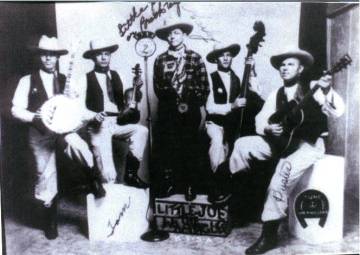 switched places with him taking
over the vocal duties with Revard. (Art Francis - one time member of the
Philadelphia Symphony Orchestra - also joined Revard as the pianist.) He was
later replaced by another ex-Tune Wrangler, George Timberlake. Another
interchange between the two bands saw Revard's fiddler, Ben McKay, replaced by
Wrangler Leonard Seago. On October 24, 1936, they had their second recording
session (cutting 16 sides and their 2nd big hit "The One Rose In My
Heart"). In early 1937, they had their 3rd recording session, cutting 12
sides. In October of 1938, the band had its final recording sessions, cutting -
of all things - mostly Hawaiian numbers including "Hawaiian
Honeymoon". Among switched places with him taking
over the vocal duties with Revard. (Art Francis - one time member of the
Philadelphia Symphony Orchestra - also joined Revard as the pianist.) He was
later replaced by another ex-Tune Wrangler, George Timberlake. Another
interchange between the two bands saw Revard's fiddler, Ben McKay, replaced by
Wrangler Leonard Seago. On October 24, 1936, they had their second recording
session (cutting 16 sides and their 2nd big hit "The One Rose In My
Heart"). In early 1937, they had their 3rd recording session, cutting 12
sides. In October of 1938, the band had its final recording sessions, cutting -
of all things - mostly Hawaiian numbers including "Hawaiian
Honeymoon". Among
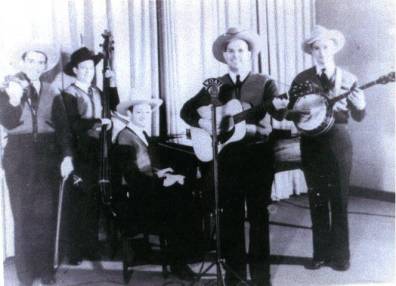 the sidemen in the band at that
time were Leonard Seago and Noah Hatley who handled the "dueling
fiddles". The twins Neal (banjo) and Beal (reeds) added their own unique
sounds to the band. One source (Rural Radio Magazine - May 1938) reported that
the band was visiting over 200 different small towns, and traveling over 100,000
miles yearly. During the following two years, Tom Dickey died, and Bill Dickey
retired to Kingsland, Texas. Charlie Poss., went on to play piano for Adolph
Hofner, in San Antonio. They disbanded, in common with most other bands, with
the advent of World War 11. the sidemen in the band at that
time were Leonard Seago and Noah Hatley who handled the "dueling
fiddles". The twins Neal (banjo) and Beal (reeds) added their own unique
sounds to the band. One source (Rural Radio Magazine - May 1938) reported that
the band was visiting over 200 different small towns, and traveling over 100,000
miles yearly. During the following two years, Tom Dickey died, and Bill Dickey
retired to Kingsland, Texas. Charlie Poss., went on to play piano for Adolph
Hofner, in San Antonio. They disbanded, in common with most other bands, with
the advent of World War 11.
Bob Wills and The Texas
Playboys. Bob Wills, born, March 6, 1905 Kosse, TX,
USA. died, May 13, 1975, Ft. Worth, TX, USA. Given name,: James Robert Wills.
Here's a photograph of Bob
Wills. And, here's another photo of Bob
Wills and Kay Kyser. Kyser is on the left, and on
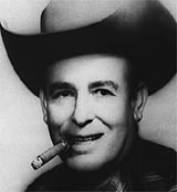 the right is W. B. Way, VP and
General Manager of Tulsa, OK, radio station KVOO. (Photo courtesy of Univ. Of
Maryland - Library of American, Broadcasting.) It was Wills and Brown who really
set the the right is W. B. Way, VP and
General Manager of Tulsa, OK, radio station KVOO. (Photo courtesy of Univ. Of
Maryland - Library of American, Broadcasting.) It was Wills and Brown who really
set the
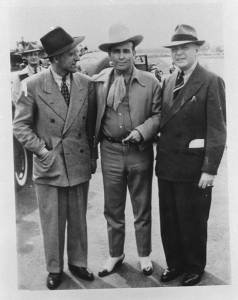 pace in the early going. When
Wills started his 13 piece band in the 1930’s, it was radical, a
"Western" band with horns and drums! The musicians union in Tulsa,
Oklahoma once refused to accept Bob Wills' players for membership on the basis
that what they played wasn't music and, therefore, they weren't musicians.
During his many recording sessions, he laid down such diverse tunes as Handy's
"St. Louis Blues"; his own "Osage Stomp"; "Basin Street
Blues"; "Trouble in Mind", the Original Dixieland Jazz Band's
"Bluin' The Blues", and even "Mexicali Rose". He even had
several hits on the 'Pop' Charts before becoming paralyzed from a cerebral
Stroke. Nevertheless, he continued on with his career (from a wheelchair), and
continued recording until 1973. In 1975, he suffered another, and this time
fatal, stroke. Bob Wills was often called the 'King of Western Swing', but it
should be noted that the title first belonged to Spade Cooley, and only went to
Wills on Cooley's death. Originally, the band was called 'Bob Wills and His
Playboys', but Jimmy Revard, whose own group was called, Jimmy Revard and the
Oklahoma Playboys, convinced Wills to rename his group the "The Texas
Playboys". He was born on a
small farm near Kosse, Limestone County, Texas. On the day Bob was born, his dad
(a champion fiddler) is reputed to have said, "I'll make a fiddler out of
you, son", and he did. By the time Bob was ten, he was playing guitar and
mandolin accompaniment for his father, - even filling in for him at times.
Wills left home at age sixteen and supported himself by doing everything
from picking cotton to preaching, with the fiddle always at his side.
In 1931, he was part of a band that found success as
‘The Light Crust Doughboys’. But
by the next year, a rift developed between Wills and the band's sponsor, - W.
Lee O'Daniel, who ran the Burrus Mill and Elevator Company (and eventually
became governor of Texas). The break, when it came, was bitter, and O'Daniel
eventually drove Wills out of Texas to Tulsa, OK. There Bob formed his 'Bob Wills and His Playboys' band and
continued to develop the music that became known as Western Swing. With vocals
by Tommy Duncan and "hollers" by the cigar-chomping Wills, the
Playboys (later called The Texas Playboys) combined jazz and string band
elements into danceable fun like "Take Me Back To Tulsa," "Right
Or Wrong," "Bubbles In My Beer" and perhaps his biggest hit,
"San Antonio Rose." Married
and divorced five times between 1935 and 1942, Wills himself was larger than
life. Over the years, The Texas Playboys had: many different versions (some as
large as 22 men); hired more than six hundred musicians; introduced more than
five hundred songs, and had a repertoire of thirty-six hundred tunes. They were
seen in the movies and their records sold more than twenty million copies. pace in the early going. When
Wills started his 13 piece band in the 1930’s, it was radical, a
"Western" band with horns and drums! The musicians union in Tulsa,
Oklahoma once refused to accept Bob Wills' players for membership on the basis
that what they played wasn't music and, therefore, they weren't musicians.
During his many recording sessions, he laid down such diverse tunes as Handy's
"St. Louis Blues"; his own "Osage Stomp"; "Basin Street
Blues"; "Trouble in Mind", the Original Dixieland Jazz Band's
"Bluin' The Blues", and even "Mexicali Rose". He even had
several hits on the 'Pop' Charts before becoming paralyzed from a cerebral
Stroke. Nevertheless, he continued on with his career (from a wheelchair), and
continued recording until 1973. In 1975, he suffered another, and this time
fatal, stroke. Bob Wills was often called the 'King of Western Swing', but it
should be noted that the title first belonged to Spade Cooley, and only went to
Wills on Cooley's death. Originally, the band was called 'Bob Wills and His
Playboys', but Jimmy Revard, whose own group was called, Jimmy Revard and the
Oklahoma Playboys, convinced Wills to rename his group the "The Texas
Playboys". He was born on a
small farm near Kosse, Limestone County, Texas. On the day Bob was born, his dad
(a champion fiddler) is reputed to have said, "I'll make a fiddler out of
you, son", and he did. By the time Bob was ten, he was playing guitar and
mandolin accompaniment for his father, - even filling in for him at times.
Wills left home at age sixteen and supported himself by doing everything
from picking cotton to preaching, with the fiddle always at his side.
In 1931, he was part of a band that found success as
‘The Light Crust Doughboys’. But
by the next year, a rift developed between Wills and the band's sponsor, - W.
Lee O'Daniel, who ran the Burrus Mill and Elevator Company (and eventually
became governor of Texas). The break, when it came, was bitter, and O'Daniel
eventually drove Wills out of Texas to Tulsa, OK. There Bob formed his 'Bob Wills and His Playboys' band and
continued to develop the music that became known as Western Swing. With vocals
by Tommy Duncan and "hollers" by the cigar-chomping Wills, the
Playboys (later called The Texas Playboys) combined jazz and string band
elements into danceable fun like "Take Me Back To Tulsa," "Right
Or Wrong," "Bubbles In My Beer" and perhaps his biggest hit,
"San Antonio Rose." Married
and divorced five times between 1935 and 1942, Wills himself was larger than
life. Over the years, The Texas Playboys had: many different versions (some as
large as 22 men); hired more than six hundred musicians; introduced more than
five hundred songs, and had a repertoire of thirty-six hundred tunes. They were
seen in the movies and their records sold more than twenty million copies.
Still, on October 18, 1968 when Tex
Ritter and Roy Acuff announced his name as the newest member of the Hall of
Fame, Wills was not in his seat. He figured he was such a long shot to win the
honor that he was backstage chatting with his buddies. Felled by a series of
strokes, Wills died in Fort Worth, Texas on May 13, 1975. He had almost
single-handedly created what we today call "Western Swing". The Big Bands Database Plus thanks Mr. Verne Buland for these
notes on Bob Wills.
Adolph Hofner and His San
Antonians. June
8, 1916, Moulton, Texas, d: June 2, 2000, San Antonio, Texas. (Almost 84) Adolph
was still playing and wowing audiences in San Antonio, TX, almost to the day of
his demise, although his health had deteriorated somewhat.
Hofner became, in his own words, "a confirmed Hillbilly" after
listening to Milton Brown and His Brownies and has continued the Western Swing
tradition for over 50 years, - longer than any other band. The original San
Antonians consisted of Adolph's brother Emil; Leonard Seago (formerly with the
Tune Wranglers); Bert Ferguson, and Floyd Tillman, who later became a well-known
songwriter. During WW2, as with the other bands, some of his best men
went into the Armed Forces. Still Hofner was able to find such replacements as
former Tune Wrangler Eddie Duncan and Leonard Brown. He also began adding Brass
players (fiddlers were becoming scarce). In
1945, when WWII had ended, Hofner moved to California where the band was
employed on the Foreman Phillips Country Barn Dances for two consecutive years.
It was during this period that the band recorded their hit tunes "Sagebrush
Shuffle" and "Alamo Rag" for the Columbia Label. In 1949, the
band returned to San Antonia, TX where they were employed by the Pearl Beer
Company, and are now called The Pearl Wranglers, who at one time used both of
Adolph's daughters as singers and drummers.
Over his career, Adolph was Elected to the Texas Western Swing Hall of
Fame, Country Music Association of Texas Hall of Fame, Country
Music Hall of Fame --Nashville, Washington Western Swing Hall of Fame,
and was the Recipient of the Encore Award--Texas Music Association, as
well as a Recipient of Western Swing Society Hall of Fame award. During
his long and illustrious career, at one time or another, he was called "The
Dean of Country Bandleaders," "The King of South Texas Swing",
"The Sultan of Swing,", and "The Prince of Polka." Once, he
was even billed as the "Bing Crosby of Country."
Bill Boyd (1910-1977 ) and
the Cowboy Ramblers. Music
historian Tom Dunbar, has tagged Bill Boyd "King of the
Instrumentals". Bill and his
young brother Jim formed a band that would become one of the legends of Western
Swing. Among their more than 250
recordings, are such hits as "Goofus"; "Over The Wave
Waltz"; "New Spanish Two Step"; "Fort Worth Rag";
"Beaumont Rag"; "Palace in Dallas"; and perhaps their most
famous recording "Under The Double Eagle". Bill Boyd went on to star
in such films as 'Along the Sundown Trail', and 'Tumbleweed Trail'. Bill's father owned a 320-acre combination cotton farm and
cattle ranch in Fannin County, Texas. The
11 children grew up in a happy home, and helped out with the farm chores.
In 1926, when Bill was just 16 years old, he and his 12-year-old brother
Jim, and two neighbors, brothers Howard and Bill Staley, formed a band and began
performing on the Greenville TX radio station KFPM. They would have continued
with their music except that their father's sudden death ended this and the
youngsters returned to help keep the family farm going.
However, the great depression of 1929 forced the sale of the property,
and Bill and Jim took up residence in Dallas, TX.
Bill worked at whatever job he
could find, while Jim became a student at the Dallas Technical High School. At this school, Jim became friends with another student,
fiddler (mandolin/clarinet) Aubrey "Art" Davis, and the two would
often play at school functions. In
1932, Bill, along with Red Perkins on Mandolin and O. .P. Alexander on French
Harp formed a trio that found work on station WFAA, remaining there for 2 years.
Later in the same year, after his graduation, brother Jim joined the
group, making it a quartet, which was promptly named 'The Cowboy Ramblers'.
August 1934 saw the group cutting their first recordings. But, in 1936,
they began recording for the RCA Victor label, eventually cutting over 250
sides. At one time or another, the band had such sidemen as Bill's young brother
John Boyd; Milton Brown Alumni Cecil Brower; Jesse Ashlock, and Fred Calhoun,
while former 'Doughboys' Milton Montgomery and Kenneth Pitts were also with the
band. Jack Adams, the Cowboy
Ramblers' manager, was not only a film distributor, but also a 'Producer's
Releasing Corporation franchisee. With Jack's help, Bill Boyd became an
overnight success as an actor, appearing in six PRC "B" cowboy films.
Some of those films also featured Art Davis, who had earlier (1938) left the
Ramblers so that he could work with famed Hollywood Cowboy star Gene Autry.
During WW2, Bill entertained servicemen and helped in War Bond Sales.
When WW2 ended, Bill and his brother Jim re-formed the Cowboy Ramblers, which
remained active until finally disbanding in the mid 1950's.
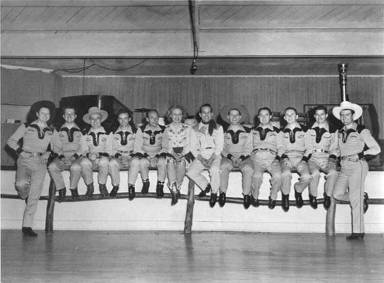 Spade Cooley and His
Orchestra. b.
Dec. 17, 1910, nr Pack Saddle Creek, OK, USA. d. 1969, in prison.
Given Name, Clyde Donnell Cooley. Tag: ‘The King of Western Swing’. Spade Cooley and His
Orchestra. b.
Dec. 17, 1910, nr Pack Saddle Creek, OK, USA. d. 1969, in prison.
Given Name, Clyde Donnell Cooley. Tag: ‘The King of Western Swing’.
This son of migrant Anglo-Indian workers was born in a Storm Cellar. As a child,
he attended Indian Public Schools. Most of his fans thought of him as Caucasian
but under law, he was considered to be 25% Indian. His first wife was a Native
American, and Cooley was hard put to support her and his son.
He got his nickname 'Spade' due to his penchant for gambling.
In Los Angeles, Spade managed an introduction to Roy Rogers, and
convinced Roy to help him get a job in the movies. Neither man could then see
that someday, the meeting would cause Spade to murder his wife, and send him to
jail, where he would die. During the day, Cooley did his film work, and during
the evenings, he found jobs as a fiddler. One day, the manager of the Venice
Pier Ballroom advised him to form a band. Spade did, and in just a few months
became a phenomenal success. So
much so, that he first leased his own club - the 8000 square foot Riverside
Rancho, which proved to be too 'small' to hold the crowds. He then transferred
the band to the Santa Monica Ballroom. Here
is a photo of the Spade Cooley Band,
with vocalist Carolina Cotton in the center and Cooley on her left side.
Carolina Cotton sang with the band for a while, and even appeared with them in a
film, 'Outlaws of the Rockies'. Later, she left Cooley and went with Tex
Williams at the time when he also left Cooley and formed his own band.
In private correspondence, Carolina Cotton's daughter (Sharon Marie) has
provided some further interesting history on her mother.
"When she joined Spade's
band in 1944, she was just known as 'Carolina'. Soon afterward, the last name
'Cotton' was added. For a time she played bass fiddle and singing/yodeling
with the band. She left the group in 1945, as she married Deuce Spriggins from
the band (he's on the far left in the photo, on the end).
He left Cooley and took several band mates with him. The marriage between
my mom and Deuce didn't last and they divorced in 1946." Carolina made a
few soundies (Scopitone videos) with both Spade and Deuce's groups. She had also
made a few records, many in the Western Swing vein. She recorded 4 tracks with
Bob Wills and the Texas Playboys ("3 Miles South of Cash in
Arkansas", "Cause I'm In Love", "All Alone", and
"You Always Keep Me in Hot Water"). If there are any surviving
recordings with Cooley, they would be radio transcriptions. With 'Deuce'
Spriggins she recorded "What's the Matter With You", and "I've
Been Down in Texas". She made at least 17 films, the earlier ones with
Spade, then with Deuce's band. As most Western performers back then, she did a
little of everything --radio, movies, stage shows, records and television."
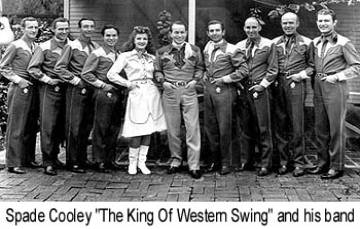 Curiously, while Spade Cooley
was finding public success, his marriage was coming apart at the seams.
His first wife obtained both a divorce and custody of their son John. During
this same time, he hired Ella Mae Evans to be his vocalist. She would later
become his second wife, - the one he would murder because of an assumed affair.
Here's a photo of the Spade Cooley Band with Ella Mae
In 1946, Cooley's "Western Swing" band started playing Rumbas,
Boogie Woogie, and even the Blues, all of which furthered his popularity. In
1949, he started his own Television show - that would last for more than 10
years. He had not only scored the music for several films, but he had also
starred in some of them. He was
immensely popular and had purchased some land in the Mojave Desert for an
amusement park, when it all ended. On
April 3, 1961, thinking his wife was having an affair with Roy Rogers, he
murdered her, in front of their daughter, Melody.
His daughter's testimony helped send him to prison where he eventually
died of a massive coronary (his fourth). He had served 8-1/2 years of his
25-year sentence, and was scheduled to be released. Curiously, while Spade Cooley
was finding public success, his marriage was coming apart at the seams.
His first wife obtained both a divorce and custody of their son John. During
this same time, he hired Ella Mae Evans to be his vocalist. She would later
become his second wife, - the one he would murder because of an assumed affair.
Here's a photo of the Spade Cooley Band with Ella Mae
In 1946, Cooley's "Western Swing" band started playing Rumbas,
Boogie Woogie, and even the Blues, all of which furthered his popularity. In
1949, he started his own Television show - that would last for more than 10
years. He had not only scored the music for several films, but he had also
starred in some of them. He was
immensely popular and had purchased some land in the Mojave Desert for an
amusement park, when it all ended. On
April 3, 1961, thinking his wife was having an affair with Roy Rogers, he
murdered her, in front of their daughter, Melody.
His daughter's testimony helped send him to prison where he eventually
died of a massive coronary (his fourth). He had served 8-1/2 years of his
25-year sentence, and was scheduled to be released.
Tex Williams (1917-1985) and
The Western Caravan. This
nine-piece band was a cooperative, formed in 1946, and the members elected Tex
Williams to front the orchestra. The bandsmen had left Spade Cooley's orchestra,
convinced that Cooley was drifting away from his hillbilly roots.
Of all the bands, it was The Western Caravan that carried on the true
Western Swing traditions, in their commitment to using string players primarily.
Tex was on guitar, and the other pieces consisted of two more guitars; fiddle,
stand up bass, electric steel lap guitar, vibes, accordion, and drums.
The new band found work immediately after their formation with a job at a
Roller Rink on Glendale Boulevard in Los Angeles. So popular was the group, that
not only was the Rink jammed to capacity on the weekends, but there was also a
very substantial crowd on weekdays. Even
though Capitol Records also signed them immediately, they had to wait two long
years before their first big hit "Smoke, Smoke, Smoke That Cigarette"
went to the top of both the Country and the Pop charts, and earned the band a
'Platinum' record.
"Texas" Jim Lewis
and The Lone Star Cowboys. b: Oct. 15, 1909, Meigs GA, d: Jan. 23,
1990. This "Western Swing" style musician grew up in Fort Myers FL,
USA. 1928 found him in Texas working as a farm hand and factory worker, all the
while dabbling in music. In 1931, he relocated to Detroit, MI, joining his
family there. He and his half-brother Jack Lewis teamed to play in
"speakeasies". In 1932, he joined the 'Swift Jewel Cowboys' in
Houston, TX. In 1934, he returned to Detroit and became a member of radio
station WJR's 'Jack West and his Circle Star Cowboys' show. With the show's
close, he formed his own 'Lone Star Cowboys', a group that worked mainly in and
around New York. From 1937-'39, he recorded for Vocalion, helping to popularize
the 'Western Swing' genre in the eastern USA. In 1940, he signed with the Decca
label. His 1944 Decca release of "Too Late To Worry, Too Blue To Cry' was
perhaps his biggest hit. During WWII, he was drafted into the U. S. Army, and
his band was taken over by Spade Cooley. After his Service Discharge at the end
of the war, he relocated to California and recorded such hits as "Leven
Miles From Leavenworth' and "Squaws Along The Yukon' (later revived by Hank
Thompson). In 1950, he moved to Seattle, WA, where he had his own radio shows.
With the introduction of Television, he was seen on the KING-TV 'Ranier Ranch'
shows. During 1950-'57, he starred in 'Sheriff Tex's Safety Junction', a
children's show, and also recorded some Children's records. In the 1960s, he
again formed a Western Swing band that played local club dates well into the
1970s. During his career, Lewis also appeared in 11 Hollywood films. In 1937, he
appeared in the film Drug Store Follies, where he played himself as the
leader of the Lone Star Cowboys Band. He went on to appear in 10 more films,
including All Aboard (1937), Swingin' in the Barn (1940) , Bad Man from Red
Butte (1940), Carolina Moon (1940), Down Mexico Way (1941), Pardon My Gun
(1942), Old Homestead, (1942), Stranger from Ponca City, (1947), Law of the
Canyon (1947), and a one-reel Short Subject Screen Snapshots: My Pal, Ringeye
(1947). In these films, he almost always appeared as himself, the Leader of the
Lone Star Cowboys Band. Happily, shortly before his death, he had gained a
long-overdue recognition as a pioneer in the 'Western Swing' genre.
Hank Thompson (1925) and His
Brazos Valley Boys. Another
of the Light Crust Doughboys that included Wills, Brown and Thompson.
Hank began his career, in his hometown of Waco, TX, playing on a cheap
guitar that his mother had bought for him. While still in High School, he landed
a job with radio station WACO, where he played as "Hank, the Hired
Hand". He continued his singing career even while attending Southern
Methodist University and the University of Texas. Globe Records signed him to a
contract, and paired him with a group known as The Brazos Valley Boys. Two of
his Globe releases, "Whoa Sailor" and "Swing Wide Your Gate of
Love" - both of which were his original tunes, brought him to the attention
of Tex Ritter and Hank and the Band were signed by Capitol Records. For the next
20 years, Hank and The Brazos Valley Boys turned out one hit after another,
including such tunes as:
"Humpty-Dumpty Heart" ,"Today", "The Wild Side Of
Life" , "Six Pack To Go" You
can find a lot of Hank’s recordings at his website
http://www.hankthompson.net/
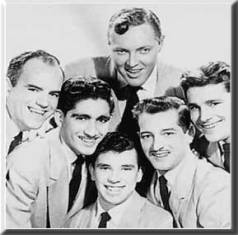 Bill Haley
(1925-1981) and His Comets. Bill Haley
(1925-1981) and His Comets.
Originally called Bill Haley and the
Saddlemen. In the 1950's, a Michigan resident, Bill Haley, was the first
'Western Bopper'.
In 1951, Haley and The Saddlemen (later
renamed The Comets), recorded "Rocket 88". Here is a photograph of Bill
Haley and the Comets, Bill at top. Then in 1954, their "Rock Around The Clock" was a
huge hit - one full year before famed DJ Alan Freed started to promote his music
tours with the term 'Rock and Roll'.
The
End.
Researched
and Composed by
Leo
C. Helmer.
|